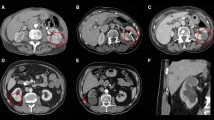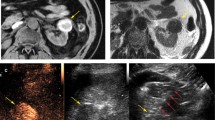Abstract
Purpose
Evaluation of clinical application of ultrasound-guided percutaneous microwave ablation treatment for T1a renal carcinoma.
Methods
Analysis of the clinical data from 31 patients with T1aN0M0 stage renal carcinoma who underwent ultrasound-guided percutaneous microwave ablation in the Department of Ultrasound of China-Japan Union Hospital of Jilin University between March 2010 and June 2014.
Results
All of the 31 patients were treated with ablation only once: 96.8% (30/31) of patients had no local recurrence or distant metastasis after ablation. One (3.2%) patient had local tumor recurrence 6 months after surgery and underwent a second microwave ablation. According to the results of 2 years of follow-up re-examinations, no further recurrence or distant metastasis was found. Moreover, 90.3% (28/31) of the patients had no complications with normal ranges of preoperative and postoperative serum creatinine and urea nitrogen levels. Complications were found in 9.7% (3/31) of the patients: one case of transient hematuria, one case of perirenal hematoma, and one case of cholecystitis; the symptoms were resolved with symptomatic treatment.
Conclusion
Ultrasound-guided percutaneous microwave ablation is a safe and effective micro-invasive therapy for T1a renal cancer patients.


Similar content being viewed by others
References
Chen W, Zheng R, Baade PD, et al. Cancer statistics in China, 2015. CA Cancer J Clin. 2016;66:115–32.
Ridge CA, Pua BB, Madoff DC. Epidemiology and staging of renal cell carcinoma. Semin Intervent Radiol. 2014;31:3–8.
Hancock SB, Georgiades CS. Kidney Cancer. Cancer J. 2016;22:387–92.
Dunnick NR. Renal cell carcinoma: staging and surveillance. AbdomRadiol (NY). 2016;41:1079–85.
Pham D, Kron T, Bressel M, et al. Image guidance and stabilization for stereotactic ablative body radiation therapy (SABR) treatment of primary kidney cancer. Pract Radiat Oncol. 2015;5:e597–605.
Ghandour RA, Danzig MR, McKiernan JM. Renal cell carcinoma: risks and benefits of nephron-sparing surgery for T1 tumors. Adv Chronic Kidney Dis. 2015;22:258–65.
Sato T, Iguchi T, Hiraki T, et al. Radiofrequency ablation of pulmonary metastases from sarcoma: single-center retrospective evaluation of 46 patients. Jpn J Radiol. 2017;35:61–7.
Georgiades C, Rodriguez R. Renal tumor ablation. Tech Vasc Interv Radiol. 2013;16:230–8.
Vetterlein MW, Jindal T, Becker A, et al. Small renal masses in the elderly: contemporary treatment approaches and comparative oncological outcomes of nonsurgical and surgical strategies. Investig Clin Urol. 2016;57:231–9.
Lin Y, Liang P, Yu XL, et al. Percutaneous microwave ablation of renal cell carcinoma is safe in patients with a solitary kidney. Urology. 2014;83:357–63.
Lin Y, Liang P, Yu XL, et al. Percutaneous microwave ablation of renal cell carcinoma is safe in patients with renal dysfunction. Int J Hyperthermia. 2016;15:1–6.
Zhang M, Liang P, Cheng ZG, et al. Efficacy and safety of artificial ascites in assisting percutaneous microwave ablation of hepatic tumours adjacent to the gastrointestinal tract. Int J Hyperthermia. 2014;30:134–41.
Ahmed M. Image-guided tumor ablation: standardization of terminology and reporting criteria—a 10-year update: supplement to the consensus document. J Vasc Interv Radiol. 2014;25:1706–8.
Crepel M, Jeldres C, Perrotte P, et al. Nephron-sparing surgery is equally effective to radical nephrectomy for T1bN0M0 renal cell carcinoma: a population-based assessment. Urology. 2010;75:271–5.
Hernández JI, Cepeda MF, Valdes F, et al. Microwave ablation: state-of-the-art review. Onco Targets Ther. 2015;8:1627–32.
Vroomen LGPH, Petre EN, Cornelis FH, et al. Irreversible electroporation and thermal ablation of tumors in the liver, lung, kidney and bone: what are the differences? Diagn Interv Imaging. 2017;98:609–17.
Isfort P, Penzkofer T, Mahnken AH. Efficacy of antegrade pyeloperfusion to protect the renal pelvis in kidney microwave ablation using an in vivo swine model. Invest Radiol. 2013;48:863–8.
Saeednejad Zanjani L, Madjd Z, Abolhasani M, et al. Cytoplasmic expression of CD133 stemness marker is associated with tumor aggressiveness in clear cell renal cell carcinoma. Exp Mol Pathol. 2017;103:218–28.
Zhao X, Wang W, Zhang S, et al. Improved outcome of percutaneous radiofrequency ablation in renal cell carcinoma: a retrospective study of intraoperative contrast-enhanced ultrasonography in 73 patients. Abdom Imaging. 2012;37:885–91.
Carrafiello G, Mangini M, Fontana F, et al. Single-antenna microwave ablation under contrast-enhanced ultrasound guidance for treatment of small renal cell carcinoma: preliminary experience. Cardiovasc Intervent Radiol. 2010;33:367–74.
Acknowledgements
This study was funded by the Finance Department of Jilin Province (No. SCZSY201618).
Author information
Authors and Affiliations
Corresponding author
Ethics declarations
Ethical statements
This study was conducted in accordance with the declaration of Helsinki. This study was conducted with approval from the Ethics Committee of Jilin University. Written informed consent was obtained from all participants.
Conflict of interest
The authors declare that they have no conflicts of interest.
About this article
Cite this article
Sui, G., Luo, Q., Du, J. et al. Clinical application of ultrasound-guided percutaneous microwave ablation in the treatment of T1aN0M0 stage renal carcinoma. J Med Ultrasonics 46, 217–222 (2019). https://doi.org/10.1007/s10396-018-0918-6
Received:
Accepted:
Published:
Issue Date:
DOI: https://doi.org/10.1007/s10396-018-0918-6




